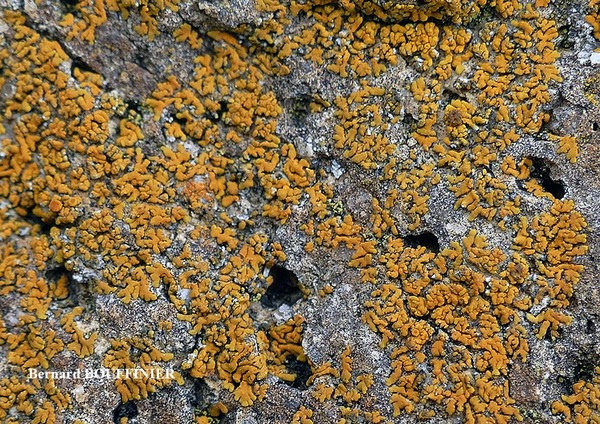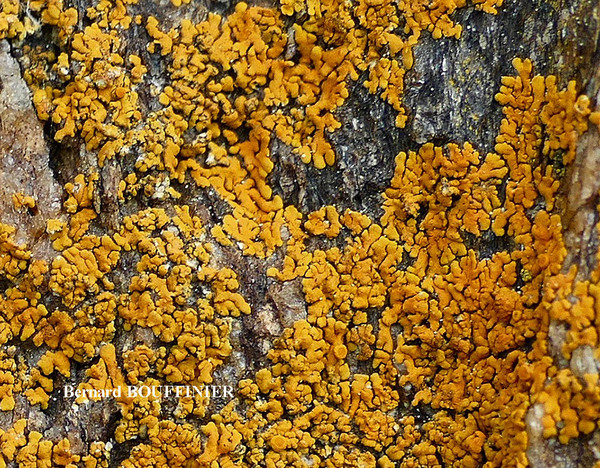Calogaya oblitterata (Pers.) P.F. Cannon & Coppins
in Cannon & al., Revisions of British and Irish Lichens, 43: 68, 2024.. Basionym: Lichen oblitteratus Pers. - Ann. Bot. (Usteri), 11: 15, 1794.
Synonyms: Calogaya arnoldii subsp. oblitterata (Pers.) Llop, Muñiz, Navarro-Rosinés, Cl. Roux & Llimona; Caloplaca arnoldii subsp. oblitterata (Pers.) Gaya; Caloplaca discernenda (Nyl.) Zahlbr.; Caloplaca miniatula (Nyl.) Zahlbr.; Caloplaca murorum f. miniatula (Nyl.) Ozenda & Clauzade; Caloplaca murorum var. oblitterata (Pers.) Jatta; Caloplaca pyraceoides B. de Lesd.; Caloplaca saxicola subsp. oblitterata (Pers.) Clauzade & Cl. Roux; Lecanora discernenda Nyl.; Lecanora miniatula Nyl.
Distribution: N - TAA (Gaya 2009), Lomb (Gaya 2009), Piem (TSB 32816), Lig (Gaya 2009). C - Sar (Herb. Vondrák 9616).
Description: Thallus crustose-placodioid, forming orbicular rosettes to 7 mm in diam., ochraceous orange to reddish-orange, epruinose. Central part of thallus with 0.3-1.3 mm wide, flat to weakly convex, irregular to elongate areoles formed by lobe fragmentation. Marginal lobes convex, irregular or finger-like, slightly broadening at tips, not or rarey forked, 0.1-1 mm long, 0.1-0.6 mm wide. Upper cortex with a 5.5-18(-22) μm thick brownish-orange upper layer, and a hyaline (6-)10-40(-47) μm thick intemal layer; medulla lax to compact. Apothecia common, highly variable, pseudolecanorine or lecanorine, more or less crowded, 0.1-1.1 mm across, round or slightly deformed by mutual compression, located either on the areoles or on the lobe bases, sessile to constricted at base. Disk flat to strongly convex, concave in young apothecia, reddish-orange to brownish, smooth. Margin lighter than disk, without differentiation between proper and thalline margin, smooth, 30-100 μm thick. Epithecium 6-8(-10) μm thick, brownish-orange K+ purple-red; hymenium, subhymenium and hypothecium colourless; paraphyses distinctly septate, forked or subapically branched, often anastomosing, 1.5-3 μm thick at base, with the last apical cell swollen and 3-7.5 μm wide. Asci 8-spored, clavate, functionally unitunicate, apically thickened with a broad internal beak, the inner part of apex and external cap I+ blue, Teloschistes-type. Ascospores 1-septate, polarilocular, hyaline, broadly to narrowly ellipsoid, (7-)8.5-11.5(14.5) x (3.5)4-5(5.5) μm; the septum (1.8-)2.5-4(-5) μm, (1.4-)1.7-2.5(-3.6) times as long as wide. Photobiont chlorococcoid. Spot tests: thallus and apothecia K+ purple-red, C-, KC-, P-. Chemistry: thallus and apothecia with parietin (major), fallacinal, emodin, teloschistin and parietinic acid (minor), corresponding with chemosyndrome A of Søchting (1997).Note: a very polymorphic taxon (see Roux & coll. 2014) with a mainly temperate to boreal distribution in Europe, also known from the southern European mountains, most frequent on base-rich siliceous rocks or on decalcified calcareous rocks, usually in nutrient-poor stands, both on vertical walls of cliffs and overhangs and on horizontal surfaces of siliceous boulders; especially the southern populations seem to prefer rather shaded conditions. The sample from Sardinia was collected in the Gennargentu Massif near Fonni, on the northern slopes of Mt. Monte Spada, at c. 1450 m. According to Vondràk & al. (2016), molecular data support the hypothesis that C. nana and C. oblitterata are mere expressions of phenotype plasticity within C. arnoldii. The name is often spelled obliterata, but the term oblitteratus used in the basionym is good Latin and does not need any correction.
Growth form: Crustose placodiomorph
Substrata: rocks
Photobiont: green algae other than Trentepohlia
Reproductive strategy: mainly sexual
In underhangs rarely wetted by rain
Commonnes-rarity: (info)
Alpine belt: rather rare
Subalpine belt: rather rare
Oromediterranean belt: very rare
Montane belt: very rare
Submediterranean belt: absent
Padanian area: absent
Humid submediterranean belt: absent
Humid mediterranean belt: absent
Dry mediterranean belt: absent

Predictive model
Herbarium samples
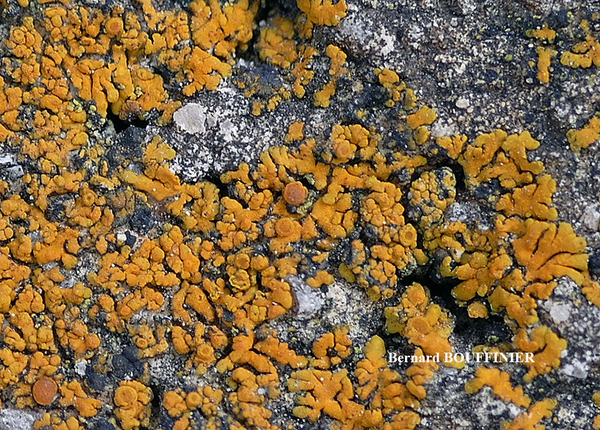
Bernard Bouffinier - Source: http://www.lichensmaritimes.org/index.php?task=fiche&lichen=851&lang=en
France, Rostellec

Bernard Bouffinier - Source: http://www.lichensmaritimes.org/index.php?task=fiche&lichen=851&lang=en
France, Rostellec
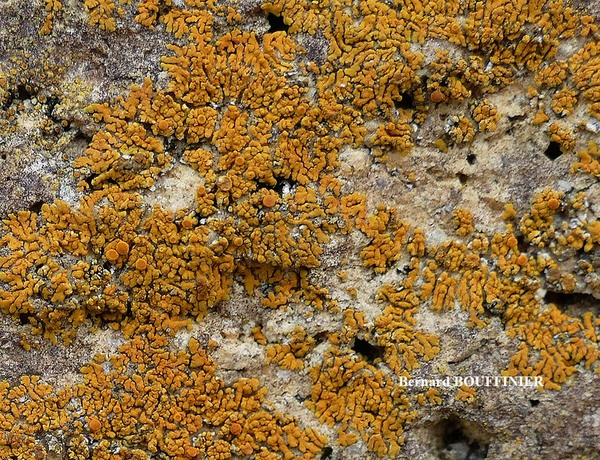
Bernard Bouffinier - Source: http://www.lichensmaritimes.org/index.php?task=fiche&lichen=851&lang=en
France, Rostellec
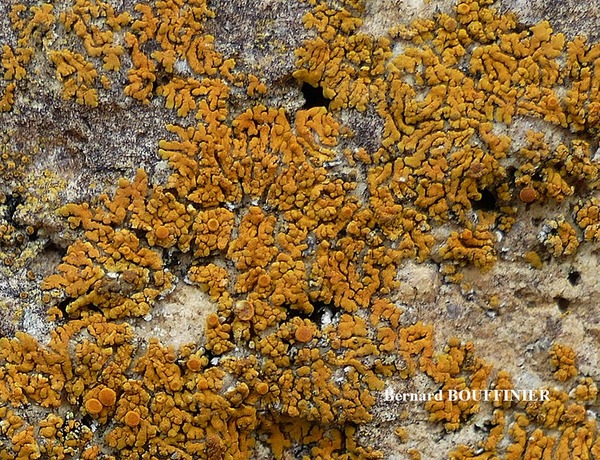
Bernard Bouffinier - Source: http://www.lichensmaritimes.org/index.php?task=fiche&lichen=851&lang=en
France, Rostellec
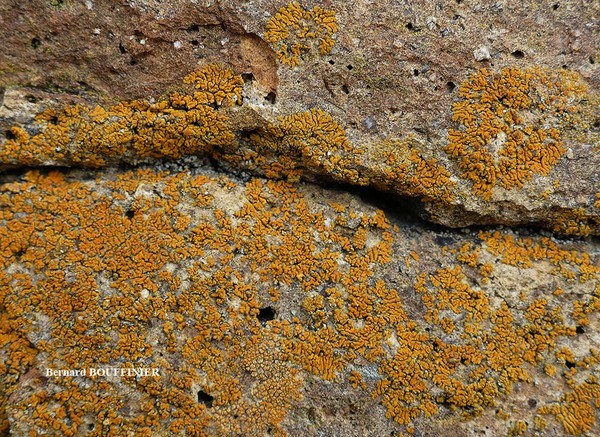
Bernard Bouffinier - Source: http://www.lichensmaritimes.org/index.php?task=fiche&lichen=851&lang=en
France, Rostellec
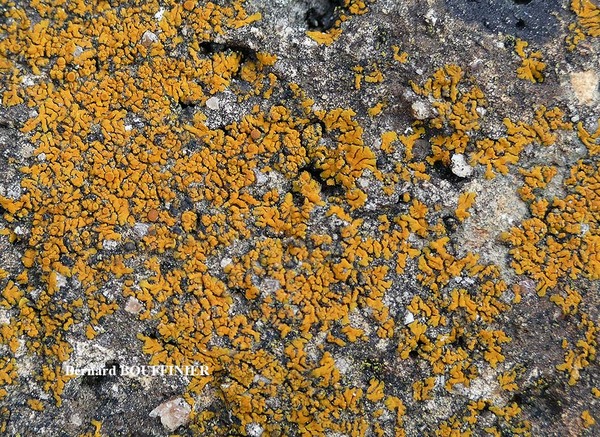
Bernard Bouffinier - Source: http://www.lichensmaritimes.org/index.php?task=fiche&lichen=851&lang=en
France, Rostellec
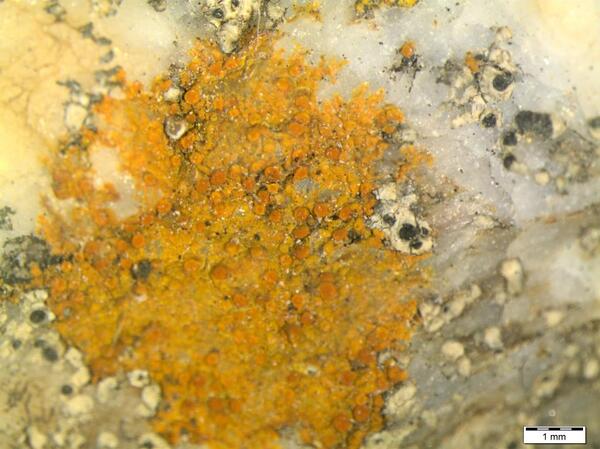
Jan Vondrak - source:http://botanika.bf.jcu.cz/lichenology/index.php?pg=8&cat=32&idx=16119
Turkey Halici 0.027
Growth form: Crustose placodiomorph
Substrata: rocks
Photobiont: green algae other than Trentepohlia
Reproductive strategy: mainly sexual
In underhangs rarely wetted by rain
Commonnes-rarity: (info)
Alpine belt: rather rare
Subalpine belt: rather rare
Oromediterranean belt: very rare
Montane belt: very rare
Submediterranean belt: absent
Padanian area: absent
Humid submediterranean belt: absent
Humid mediterranean belt: absent
Dry mediterranean belt: absent

Predictive model
| Herbarium samples |

Bernard Bouffinier - Source: http://www.lichensmaritimes.org/index.php?task=fiche&lichen=851&lang=en
France, Rostellec

Bernard Bouffinier - Source: http://www.lichensmaritimes.org/index.php?task=fiche&lichen=851&lang=en
France, Rostellec

Bernard Bouffinier - Source: http://www.lichensmaritimes.org/index.php?task=fiche&lichen=851&lang=en
France, Rostellec

Bernard Bouffinier - Source: http://www.lichensmaritimes.org/index.php?task=fiche&lichen=851&lang=en
France, Rostellec

Bernard Bouffinier - Source: http://www.lichensmaritimes.org/index.php?task=fiche&lichen=851&lang=en
France, Rostellec

Bernard Bouffinier - Source: http://www.lichensmaritimes.org/index.php?task=fiche&lichen=851&lang=en
France, Rostellec

